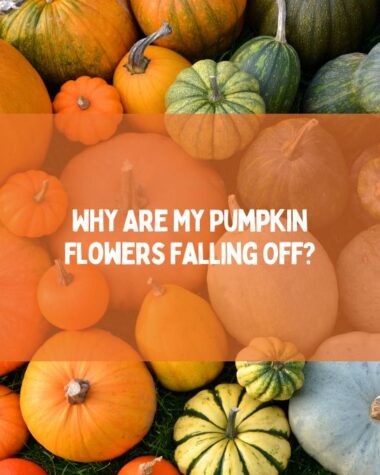Pumpkin plants are popular both in home gardens and on farms because their fruits are tasty and good for you. But pumpkin plants are prone to a number of diseases that can cause a big drop in yield and quality, which can cost money. Pathogens like fungi, viruses, bacteria, and insects are to blame for these common pumpkin problems.
These diseases of pumpkin plants can affect various parts of the plant, including the leaves, stems, and fruits, and can lead to reduced yield, poor-quality produce, and even plant death.
Effective disease management strategies for pumpkin plants include planting disease-resistant varieties, crop rotation, sanitation, and the use of fungicides and insecticides.
After reading this article, you will be able to protect your pumpkin plants from different types of diseases.
Let’s start.
9 Major Diseases Of Pumpkin Plants You Must Know
As a passionate gardener, I know firsthand the frustration of discovering diseases in pumpkin plants. These diseases can quickly spread and devastate your entire pumpkin crop if left untreated.
It’s important to monitor pumpkin plants regularly and take preventive measures, such as crop rotation, proper irrigation, and good sanitation practices, to reduce the risk of disease.
Here are 9 major diseases of pumpkin plants that every gardener should be aware of in order to protect their plants and ensure a healthy harvest.
1. Powdery Mildew
Powdery mildew is a common fungus that affects pumpkin plants. It is caused by several species of fungi in the order Erysiphales, with the most common being Podosphaera xanthii and Erysiphe cichoracearum.
Symptoms of powdery mildew on pumpkin plants include white or greyish powdery spots on the leaves, stems, and fruit. The spots may start off small and become larger as the disease progresses. The leaves may also become distorted, and the plant may produce fewer fruits.
Related Reading
2. Fusarium Wilt
Fusarium wilt disease is a plant disease caused by various species of the Fusarium fungus. It affects a wide range of plants, including tomatoes, bananas, cotton, cucumbers, pumpkins, and many others.
Characterization of Fusarium Wilt in Pumpkin Plants
The Fusarium wilt disease is characterized by wilting and yellowing of the leaves, spots in pumpkin leaf disease, stunting of growth, and ultimately, death of the plant.
Symptoms of Fusarium Wilt in Pumpkin Plants
The symptoms of Fusarium wilt in pumpkin plants may initially appear on one side of the plant, with the pumpkin leaves on that side of the plant wilting and yellowing before the symptoms spread to other parts of the plant.
Over time, the entire plant may become affected, and the fruit may become smaller and less flavorful. Fusarium wilt on pumpkin plants is usually stopped by a combination of cultural practices and fungicides, such as crop rotation and cleanliness.
3. Bacterial Wilt
Bacterial wilt diseases of pumpkin plants are a serious problem for growers. The two most common bacterial wilt diseases of pumpkin plants are caused by the bacteria Erwinia tracheiphila and Ralstonia solanacearum.
Erwinia tracheiphila, which is also called “cucurbit bacterial wilt,” spreads to pumpkin plants when striped or spotted cucumber beetles eat them. The disease causes the leaves to wilt, turn yellow, and dry out. Eventually, the plant dies from the disease.
The bacteria block the water-conducting tissues of the plant, leading to a rapid decline in the health of the plant.
Related Reading:
4. Anthracnose
Anthracnose is a fungal disease that affects pumpkin plants. It can cause dark, sunken lesions on leaves, stems, and fruit, leading to reduced plant vigor, lower yields, and even plant death.
Prevention of Anthracnose in Pumpkin Plants
To prevent anthracnose from affecting your pumpkin plants, it’s important to practice good crop rotation, avoid planting in areas where the disease has been present in the past, and use fungicides when necessary.
Keeping the plants well-watered and fed can also help keep them healthy and stop the disease from taking hold.
5. Verticillium Wilt
Verticillium wilt is a fungal disease that affects many plants, including pumpkin plants. The fungus that causes the disease lives in the soil and enters the plant through the roots, where it blocks the plant’s vascular system and interferes with water and nutrient uptake.
Prevention of Verticillium Wilt in Pumpkin Plants
There is no cure for Verticillium wilt, and once a plant is infected, it cannot be cured.
However, there are some things you can do to reduce the risk of the disease spreading to healthy plants. Some of these are rotating crops, planting pumpkins that are resistant to the disease, and getting rid of infected plants from the garden.
6. Root Rot
Root rot is a fungal disease that affects the roots of many plants, including pumpkin plants. The fungus that causes root rot lives in the soil and thrives in wet, poorly drained soil.
Signs of Root Rot in Pumpkin Plants
One of the first signs of root rot in pumpkin plants is stunted growth. The plants may not grow as tall or as large as healthy plants, and they may have smaller leaves.
As the disease progresses, the leaves of pumpkin plants may wilt and turn yellow or brown. This is because the roots are not able to absorb enough water and nutrients from the soil.
Root rot can reduce the yield of pumpkin plants by up to 50%. The disease can cause the fruit to be smaller and less numerous than on healthy plants.
Prevention of Root Rot in Pumpkin Plants
To prevent root rot in pumpkin plants, it is important to plant them in well-drained soil and avoid overwatering. It is also a good idea to rotate crops and avoid planting pumpkins in the same spot every year.
Read More:
7. Mosaic Viruses
Mosaic viruses can do a lot of damage to pumpkin plants, causing them to produce less and grow more slowly. These viruses are spread by insect vectors such as aphids, whiteflies, and beetles, as well as through contaminated tools and seeds. This virus is spread by pumpkin pests and diseases.
Symptoms of Mosaic Viruses in Pumpkin Plants
The symptoms of mosaic viruses on pumpkin plants include mottled, yellow, and distorted leaves, which can ultimately lead to the death of the plant.
Additionally, infected pumpkins may have reduced fruit size and weight, as well as a reduced number of fruits per plant. The virus can also cause fruit deformities such as warts and ridges.
Prevention of Mosaic Viruses in Pumpkin Plants
There is no cure for mosaic viruses once a plant is infected, so prevention is the best strategy. This includes planting disease-resistant varieties, controlling insect vectors, and using disease-free seeds and tools.
Read More:
8. Alternaria Leaf Spots
Alternaria leaf spot is a common fungus that can affect pumpkin plants, causing damage to the foliage and reducing yields. The disease is caused by the fungus Alternaria cucumerina, which thrives in warm and humid conditions on pumpkin leaves.
Symptoms of Alternaria leaf spots in Pumpkin Plants
The symptoms of Alternaria leaf pumpkin spot include circular or irregular-shaped lesions on the leaves that are initially small and water-soaked but can grow larger and turn dark brown to black over time. In severe cases, the lesions can merge, causing large areas of the leaf to die.
Prevention of Alternaria leaf spots in Pumpkin Plants
Prevention is the key to managing Alternaria pumpkin leaf diseases. This includes planting disease-resistant varieties, avoiding overhead watering, and ensuring good air circulation around the plants. Fungicides can also be used to control the disease.
9. Early And Late Blight
Early pumpkin blight and late pumpkin blight are fungal diseases that can affect a wide range of plants, including pumpkins. Early blight is caused by the fungus Alternaria solani.
Early and late blight Pumpkin Plant Symptoms
Symptoms of early blight typically appear on the lower leaves of pumpkin plants and may include circular, brownish-black spots with yellow haloes. As the disease progresses, the spots may enlarge and coalesce, causing the affected leaves to wither and die.
If left untreated, early blight can eventually cause defoliation and reduce the yield of the pumpkin crop.
Early and late blight Pumpkin Plant of Prevention
To prevent the spread of early and late blight on pumpkin plants, it’s important to practice good sanitation and crop management techniques. This can include removing infected plant debris, avoiding overhead watering, and rotating crops to prevent the buildup of fungal spores in the soil.
Related Reading
- How Proper Eggplant Spacing Can Maximize Your Harvest?
- What is bumpy zucchini? Why is my zucchini bumpy?
- The Ultimate Guide To Cucumber Pests and Diseases
Conclusion
These diseases can cause significant damage to pumpkin plants, leading to reduced yield, poor-quality fruit, and even plant death.
It’s essential to identify and diagnose the diseases correctly and take appropriate action as soon as possible to minimize damage to the pumpkin plants.
Pumpkin diseases can be prevented and treated with good cultural practices, like crop rotation, good sanitation, and the use of fungicides and other treatments at the right time.
I hope this article will help you protect your pumpkin plants from different diseases.
Thanks for reading!







